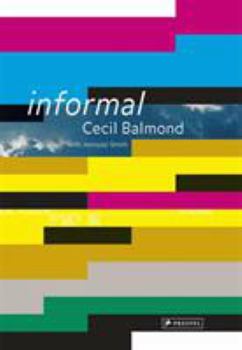Informal
Select Format
Select Condition 
Book Overview
Balmond is making the transition from structural engineer working alongside other architects to an architect in his own right. His structural thinking differs from that of others in his field, in its... This description may be from another edition of this product.
Format:Paperback
Language:English
ISBN:3791337769
ISBN13:9783791337760
Release Date:April 2007
Publisher:Prestel Publishing
Length:391 Pages
Weight:1.25 lbs.
Dimensions:1.3" x 4.7" x 7.3"
Customer Reviews
5 ratings
Outstanding...
Published by Thriftbooks.com User , 14 years ago
I wanted to dislike Informal. I was frothing at the mouth ready to find fault with the book...up until I read it. And it was stellar. I'm actually kind of upset this isn't required reading in my architecture school. The ultimate benefit of reading Informal is getting a glimpse into how Balmond thinks. Regardless of whether or not the end products were built, or nice to look at, seeing how this guy approaches problems is humbling. Balmond explores structure as a possibility rather than a limitation. He conceives highly imaginative and innovative solutions that work symbiotically with the architecture. His writes with humane prose and presents his ideas with inquisitive boyishness, in no way belying his erudition. Genius book by a genius. Worth every dime.
Informal (Architecture)
Published by Thriftbooks.com User , 17 years ago
This is one of the most important book about informal architecture. It is about how idea becomes possible reality. Instead of accept the way it is, it playfully explores the other way of merging engineering & architecture.
Wow !
Published by Thriftbooks.com User , 18 years ago
Informal is an extraordinary work. I guess the reason why it's so shocking is that the content of the book is not like those static structural forms or solutions that we see in structural class. The case studies that Balmond brings to the table are very recent and genuine by star architects. I guess I was shocked by the fact that all these architects are not structurally oriented architects such as Foster/ Piano/ Calatrava/ Hopkins. Rather, they are theoretically approaching architects such as Koolhaas/ Liebskind; or, tectonically approaching architects such as Siza. I never thought projects by them had anything to do with structural or mathmatical innovation. Reading Informal, one can easily detect where the originality lie in each project. Sometimes it's in the irregularity of geometry or sometimes it's in mathmatical mystery. Balmond contends that they are all in mother nature. Unlike a formal structural engineering (e.g. Peter Rice) Balmond's originality comes from the informal networks. In High-tech, the ingenuity of structural entity was condensed into joinery. Informal networks is much more diverse and complex than that. It is against the conventional formal structural idea of hierarchy/center/symmetry. Balmond argues, formal approach is defining a problem in a "fixed" or "contained" manner; hence, leading to a same old idea of solution/ detailing. In Informal, Balmond redefines it in a more active/dynamic geometry, to bring about unexpected realities. Sometimes through structural innovation and sometimes through special surface treatment, Balmond promoted and realized the ideas of star architects. Overall, he has freed architecture from the "Cartesian Cage".
Balmond Student
Published by Thriftbooks.com User , 21 years ago
Cecil Balmond is passionate and inspirational. When working with him, you know there is something amazing happening. I had the pleasure of having him as a studio instructor at Yale University, School of Architecture. Cecil believes in the possibilities of architecture and engineering working together in ways that enhance and grace both fields. This book brings his insight and passions together. I highly recommend it to engineers and architects alike.
A dialogue
Published by Thriftbooks.com User , 21 years ago
Informal is a terrific read; it places me right at the table as the author engages with his architect collaborators pursuing innovative building designs. The range is fascinating, from a box shape in the Villa Bordeaux to a curvilinear form in the Arnhem Interchange to the serene and effortless canopy in Lisbon. In each project the author establishes simple initial moves which lead ultimately to new configurations and importantly develops throughout the book a rigorous basis for exploring the non linear. This is welcome in an age when so much architectural form making is whimsical. As an architect I was fascinated how this book also brings out the lyrical and poetic inherent in structure. Best of all perhaps is the 27 sectioned speculation at the end on the anatomy of form, and an insight into the structure of organisation itself. In conjunction with his intriguing earlier book Number 9 Balmond sets out a new agenda for designers everywhere, including architects and engineers.





